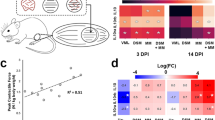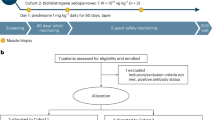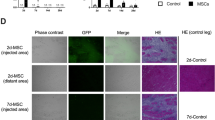Abstract
Developing methodologies to enhance skeletal muscle regeneration and hasten the restoration of muscle function has important implications for minimizing disability after injury and for treating muscle diseases such as Duchenne muscular dystrophy. Although delivery of various growth factors, such as insulin-like growth factor-I (IGF-I), have proved successful in promoting skeletal muscle regeneration after injury, no study has compared the efficacy of different delivery methods directly. We compared the efficacy of systemic delivery of recombinant IGF-I protein via mini-osmotic pump (∼1.5 mg/kg/day) with a single electrotransfer-assisted plasmid-based gene transfer, to hasten functional repair of mouse tibialis anterior muscles after myotoxic injury. The relative efficacy of each method was assessed at 7, 21 and 28 days post-injury. Our findings indicate that IGF-I hastened functional recovery, regardless of the route of IGF-I administration. However, gene transfer of IGF-I was superior to systemic protein administration because in the regenerating muscle, this delivery method increased IGF-I levels, activated intracellular signals (Akt phosphorylation), induced a greater magnitude of myofiber hypertrophy and hastened functional recovery at an earlier time point (14 days) after injury than did protein administration (21 days). Thus, the relative efficacy of different modes of delivery is an important consideration when assessing the therapeutic potential of various proteins for treating muscle injuries and skeletal muscle diseases.
This is a preview of subscription content, access via your institution
Access options
Subscribe to this journal
Receive 12 print issues and online access
$259.00 per year
only $21.58 per issue
Buy this article
- Purchase on Springer Link
- Instant access to full article PDF
Prices may be subject to local taxes which are calculated during checkout




Similar content being viewed by others
References
Huard J, Li Y, Fu FH . Muscle injuries and repair: current trends in research. J Bone Joint Surg Am 2002; 84: 822–832.
Chargé SB, Rudnicki MA . Cellular and molecular regulation of muscle regeneration. Physiol Rev 2004; 84: 209–238.
Suzuki S, Yamanouchi K, Soeta C, Katakai Y, Harada R et al. Skeletal muscle injury induces hepatocyte growth factor expression in spleen. Biochem Biophys Res Commun 2002; 292: 709–714.
Floss T, Arnold HH, Braun T . A role for FGF-6 in skeletal muscle regeneration. Genes Dev 1997; 11: 2040–2051.
Kurek JB, Bower JJ, Romanella M, Koentgen F, Murphy M, Austin L . The role of leukemia inhibitory factor in skeletal muscle regeneration. Muscle Nerve 1997; 20: 815–822.
Edwall D, Schalling M, Jennische E, Norstedt G . Induction of insulin-like growth factor I messenger ribonucleic acid during regeneration of rat skeletal muscle. Endocrinology 1989; 124: 820–825.
Levinovitz A, Jennische E, Oldfors A, Edwall D, Norstedt G . Activation of insulin-like growth factor II expression during skeletal muscle regeneration in the rat: correlation with myotube formation. Mol Endocrinol 1992; 6: 1227–1234.
Marsh DR, Criswell DS, Hamilton MT, Booth FW . Association of insulin-like growth factor mRNA expressions with muscle regeneration in young, adult, and old rats. Am J Physiol Regul Integr Comp Physiol 1997; 273: R353–R358.
Engert JC, Berglund EB, Rosenthal N . Proliferation precedes differentiation in IGF-I-stimulated myogenesis. J Cell Biol 1996; 135: 431–440.
Bark TH, McNurlan MA, Lang CH, Garlick PJ . Increased protein synthesis after acute IGF-I or insulin infusion is localized to muscle in mice. Am J Physiol Endocrinol Metab 1998; 275: E118–E123.
Barton-Davis ER, Shoturma DI, Sweeney HL . Contribution of satellite cells to IGF-I induced hypertrophy of skeletal muscle. Acta Physiol Scand 1999; 167: 301–305.
Machida S, Booth FW . Insulin-like growth factor 1 and muscle growth: implication for satellite cell proliferation. Proc Nutr Soc 2004; 63: 337–340.
Jacquemin V, Furling D, Bigot A, Butler-Browne GS, Mouly V . IGF-1 induces human myotube hypertrophy by increasing cell recruitment. Exp Cell Res 2004; 299: 148–158.
Semsarian C, Sutrave P, Richmond DR, Graham RM . Insulin-like growth factor (IGF-I) induces myotube hypertrophy associated with an increase in anaerobic glycolysis in a clonal skeletal-muscle cell model. Biochem J 1999; 339: 443–451.
Musaro A, McCullagh K, Paul A, Houghton L, Dobrowolny G, Molinaro M et al. Localized Igf-1 transgene expression sustains hypertrophy and regeneration in senescent skeletal muscle. Nat Genet 2001; 27: 195–200.
Musaro A, Giacinti C, Borsellino G, Dobrowolny G, Pelosi L, Cairns L et al. Stem cell-mediated muscle regeneration is enhanced by local isoform of insulin-like growth factor I. Proc Natl Acad Sci USA 2004; 101: 1206–1210.
Rabinovsky ED, Gelir E, Gelir S, Lui H, Kattash M, DeMayo FJ et al. Targeted expression of IGF-1 transgene to skeletal muscle accelerates muscle and motor neuron regeneration. FASEB J 2003; 17: 53–55.
Barton-Davis ER, Shoturma DI, Musaro A, Rosenthal N, Sweeney HL . Viral mediated expression of insulin-like growth factor I blocks the aging-related loss of skeletal muscle function. Proc Natl Acad Sci USA 1998; 95: 15603–15607.
Lee S, Barton ER, Sweeney HL, Farrar RP . Viral expression of insulin-like growth factor-I enhances muscle hypertrophy in resistance-trained rats. J Appl Physiol 2004; 96: 1097–1104.
Takahashi T, Ishida K, Itoh K, Konishi Y, Yagyu KI, Tominaga A et al. IGF-I gene transfer by electrotransfer promotes regeneration in a muscle injury model. Gene Therapy 2003; 10: 612–620.
Kasemkijwattana C, Menetrey J, Bosch P, Somogyi G, Moreland MS, Fu FH et al. Use of growth factors to improve muscle healing after strain injury. Clin Orthop Relat Res 2000; 370: 272–285.
Menetrey J, Kasemkijwattana C, Day CS, Bosch P, Vogt M, Fu FH et al. Growth factors improve muscle healing in vivo. J Bone Joint Surg Br 2000; 82: 131–137.
Schertzer JD, Plant DR, Lynch GS . Optimizing plasmid-based gene transfer for investigating skeletal muscle structure and function. Mol Ther 2006; 13: 795–803.
Wells DJ . Improved gene transfer by direct plasmid injection associated with regeneration in mouse skeletal muscle. FEBS Lett 1993; 332: 179–182.
Wells DJ, Maule J, McMahon J, Mitchell R, Damien E, Poole A et al. Evaluation of plasmid DNA for in vivo gene therapy: factors affecting the number of transfected fibers. J Pharm Sci 1998; 87: 763–768.
Davis HL, Demeneix BA, Quantin B, Coulombe J, Whalen RG . Plasmid DNA is superior to viral vectors for direct gene transfer into adult mouse skeletal muscle. Hum Gene Ther 1993; 4: 733–740.
Vitadello M, Schiaffino MV, Picard A, Scarpa M, Schiaffino S . Gene transfer in regenerating muscle. Hum Gene Ther 1994; 5: 11–18.
Gregorevic P, Plant DR, Lynch GS . Administration of insulin-like growth factor-I improves fatigue resistance of skeletal muscles from dystrophic mdx mice. Muscle Nerve 2004; 30: 295–304.
Gregorevic P, Plant DR, Leeding KS, Bach LA, Lynch GS . Improved contractile function of the mdx dystrophic mouse diaphragm muscle after insulin-like growth factor-I administration. Am J Pathol 2002; 161: 2263–2272.
Wong SH, Lowes KN, Quigley AF, Marotta R, Kita M, Byrne E et al. DNA electroporation in vivo targets mature fibres in dystrophic mdx muscle. Neuromuscul Disord 2005; 15: 630–641.
Beitzel F, Gregorevic P, Ryall JG, Plant DR, Sillence MN, Lynch GS . β2-adrenoceptor agonist fenoterol enhances functional repair of regenerating rat skeletal muscle after injury. J Appl Physiol 2004; 96: 1385–1392.
Gregorevic P, Plant DR, Stupka NS, Lynch GS . Changes in contractile activation characteristics of rat fast and slow skeletal muscle fibres during regeneration. J Physiol 2004; 558: 549–560.
Shavlakadze T, Winn N, Rosenthal N, Grounds MD . Reconciling data from transgenic mice that overexpress IGF-I specifically in skeletal muscle. Growth Horm IGF Res 2005; 15: 4–18.
Goldspink G . Mechanical signals, IGF-I gene splicing, and muscle adaptation. Physiology 2005; 20: 232–238.
Barton ER . Viral expression of insulin-like growth factor-I isoforms promotes different responses in skeletal muscle. J Appl Physiol 2006; 100: 1778–1784.
Burkholder TJ, Fingado B, Baron S, Lieber RL . Relationship between muscle fiber types and sizes and muscle architectural properties in the mouse hindlimb. J Morphol 1994; 221: 177–190.
Schertzer JD, Plant DR, Ryall JG, Beitzel F, Stupka N, Lynch GS . β2-agonist administration increases sarcoplasmic reticulum Ca2+-ATPase activity in aged rat skeletal muscle. Am J Physiol Endocrinol Metab 2005; 288: E526–E533.
Schertzer JD, Green HJ, Duhamel TA, Tupling AR . Mechanisms underlying increases in SR Ca2+-ATPase activity after exercise in rat skeletal muscle. Am J Physiol Endocrinol Metab 2004; 284: E597–E610.
Acknowledgements
This work was supported by research grants from the Muscular Dystrophy Association (USA) and the National Health & Medical Research Council (Australia).
Author information
Authors and Affiliations
Corresponding author
Additional information
Supplementary Information accompanies the paper on Gene Therapy website (http://www.nature.com/gt)
Supplementary information
Rights and permissions
About this article
Cite this article
Schertzer, J., Lynch, G. Comparative evaluation of IGF-I gene transfer and IGF-I protein administration for enhancing skeletal muscle regeneration after injury. Gene Ther 13, 1657–1664 (2006). https://doi.org/10.1038/sj.gt.3302817
Received:
Revised:
Accepted:
Published:
Issue Date:
DOI: https://doi.org/10.1038/sj.gt.3302817
Keywords
This article is cited by
-
Impact of intramuscular administration of lipid-soluble and water-soluble vehicles into regenerating muscle at the distinct phases of skeletal muscle regeneration
The Journal of Physiological Sciences (2018)
-
Relationship of anabolic and catabolic biomarkers with muscle strength and physical performance in older adults: a population-based cross-sectional study
BMC Musculoskeletal Disorders (2015)
-
Gene therapy approaches to regenerating the musculoskeletal system
Nature Reviews Rheumatology (2015)
-
Monocyte/Macrophage-derived IGF-1 Orchestrates Murine Skeletal Muscle Regeneration and Modulates Autocrine Polarization
Molecular Therapy (2015)
-
Gene and cell therapy for muscle regeneration
Current Reviews in Musculoskeletal Medicine (2015)



